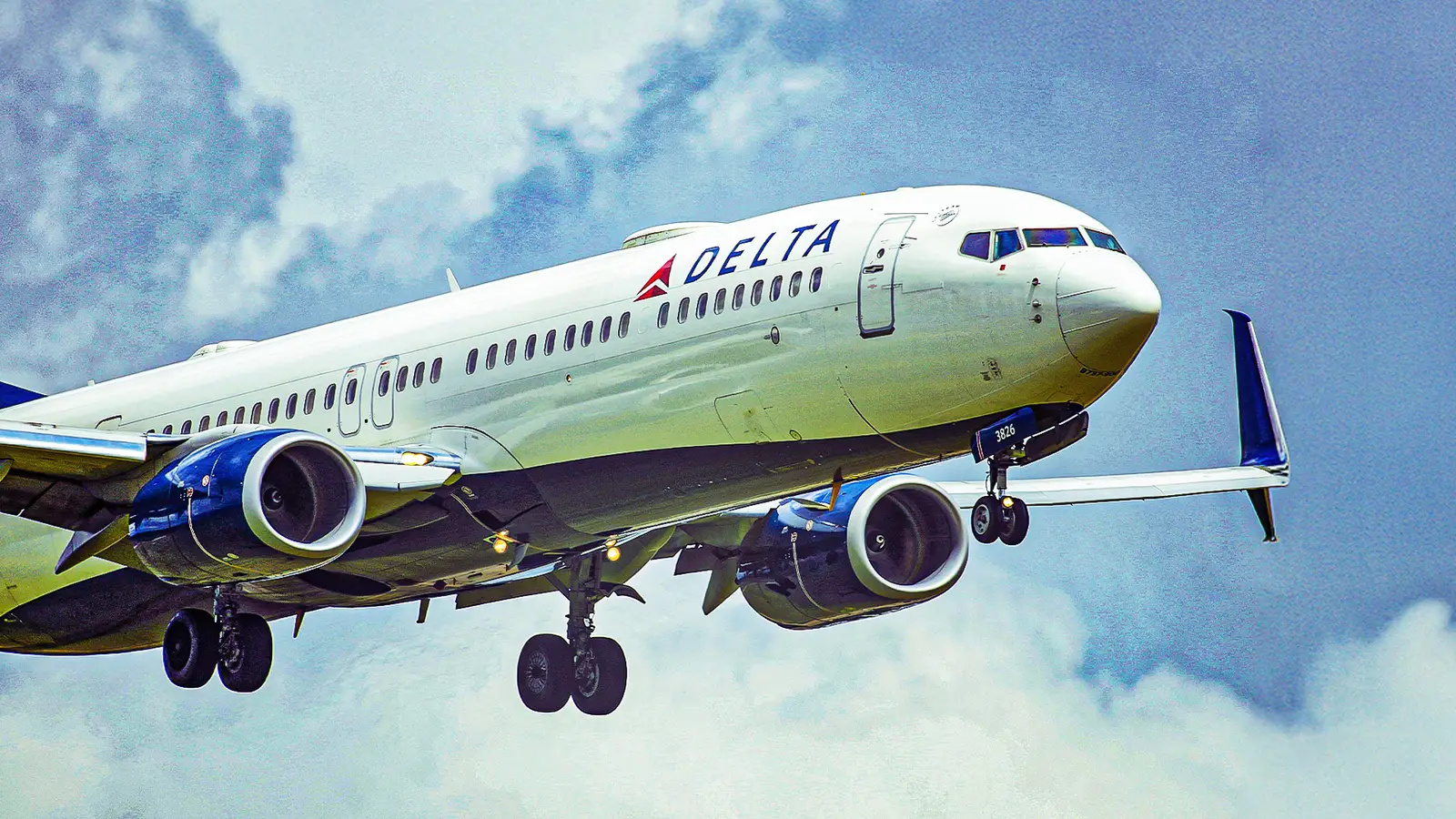
US-based Delta Air Lines, has been retrofitting its fleet of Boeing 737s with upgraded Split Scimitar winglets in recent years, in order to improve the operational efficiency of these aircraft, thereby reducing the carbon footprint of the carrier’s operations, reducing fuel burn, and subsequently bringing costs down.
What Are Split Scimitar Winglets?
For context, since 2015, Delta Air Lines has been purchasing upgraded winglets known as Split Scimitar Winglets, from Aviation Partners Boeing (APB) and retrofitting its fleet of previous-generation Boeing 737-800 and Boeing 737-900 aircraft. Traditionally, these Boeing aircraft were manufactured (if opted) with blended winglets, in which the wings of the aircraft had a smooth curve upwards at the wingtips. Split Scimitar Winglets, on the other hand, have a similar upward curve at the wingtip, but are shaped a bit differently, while also featuring a smaller aerodynamic fin in a downward direction, forming an acute angle between the upward curve and the downward-facing fin.
In the image above of a Delta Boeing 737-900ER, the Split Scimitar Winglets can be clearly seen, which has a downward-protruding aerodynamic fin at the wingtip along with a traditional blended winglet (upward curve at the wingtip). While the Split Scimitar Winglets look very similar to the winglets seen on the latest generation Boeing 737MAX aircraft (these have AT winglets), it is important to note that there are some differences between these two winglets.
Advantages Of The Split Scimitar Winglets
Now that the distinction between Split Scimitar and Blended winglets has been established, the next question is, why is Delta doing these retrofits?
Fundamentally, winglets of any kind improve the flight of an aircraft, as these winglets guide the airflow at the wingtips in a manner that reduces wingtip vortices, which not only adds to the drag force (induced drag) produced by the aircraft, but also creates wake turbulence behind the aircraft, which can be harmful for other aircraft flying close by.
Therefore, lowering the drag, the fuel burn, the fuel costs, as well as reducing the carbon emissions, subsequently, results in an overall improvement in efficiency and flight operations.
While the original 737 variants did not have any form of winglets, later models, such as the aforementioned 737-800s and 737-900s, were manufactured with blended winglets, and the succeeding MAX variants with the AT Winglets, at which point, a similar version of the winglet was available for retrofit for the -800s and -900s known as Split Scimitar Winglets.
Let’s Talk Numbers
Now that the function of the winglets has been established, and it is understood that these winglets bring airlines savings in terms of fuel burn and fuel costs, the next question is “by how much”? Data published by airlines that have retrofitted their 737s with Split Scimitar Winglets, such as flydubai, Transavia, and Ryanair, all cite fuel savings of 1.5%.
While this may seem small, considering the overall savings an airline experiences across its fleet of a large number of retrofitted 737s, the fuel and cost savings can be substantial. Delta last year reported that retrofitting these winglets saves the airline 3.3 million gallons of fuel annually, while flydubai’s report from 2019 claims these winglets reduce fuel burn by 200,000 liters per aircraft per year, which translates to over 510 tonnes of CO2 reduction per aircraft per year.
It is worth noting that the savings on a per-flight basis will vary depending on the distance flown. Fuel savings can range between 1.6% and 2.2% for sector lengths of 1000NM and 3000NM, respectively. Manufacturer – Aviation Partners Boeing lists the prices starting from $430,000 for retrofitting Split Scimitar winglets on Boeing 737-700/800/900/900ER variants.
Other advantages of retrofitting these winglets include improved range for the aircraft, as reported by Transavia in 2019, where the airline’s retrofitted aircraft had an improved range of around 108NM (200 km). Range can vary depending on how an airline configures its aircraft, and, thus, the aircraft range will vary between airlines and sometimes even within an airline.
Overall, given the advantages these winglets provide, they definitely help Delta reduce its costs and head the airline towards its net-zero carbon emissions and sustainability goals. Therefore, it made financial sense for the airline to invest in improving the efficiency of its older-generation narrowbody aircraft until Delta started receiving its MAX aircraft.
Other Retrofits Within Delta’s Fleet
Given that Delta Air Lines still operates a considerable fleet of older-generation aircraft, which are less efficient to operate, it is not surprising that the carrier, over the years, has also chosen to retrofit some of these aircraft with winglets to improve operational efficiency.
The airline’s fleet data show the carrier still operates a fleet of older aircraft, of which the Boeing 757-200/300 and Boeing 767-300ER variants have been retrofitted with blended winglets as seen below. These aircraft were originally manufactured by Boeing without winglets, but in 2007, Delta began retrofitting these aircraft types with blended winglets for the purposes of improving operational efficiency.
In a press release by Delta in 2009, the COO at the time, Jim Whitehurst, stated,
“We expect to see a minimum of 3.5 percent improvements in our fuel consumption and a minimum of 5 percent in our range thanks to this added technology.”
Additionally, the airline reported that the retrofitted Boeing 757-200s saw a range increase of 200 NM while the larger 767-300ERs saw a range increase of 350 NM. Data from ch-aviation shows that the carrier currently has the following number of Boeing 757s and Boeing 767s within its fleet:
Split Scimitar Winglets On Airbus Aircraft
Like Boeing, a variety of different Airbus aircraft have different types of winglets featured at the tip of their wings. From the smallest A320 family aircraft to the world’s largest passenger jet, the Airbus A380, and even the adopted A220 aircraft, all feature different types of winglets. However, none of these aircraft have a Split Scimitar Winglet. Or do they?
Back in 2017, Airbus designed a Split Scimitar-style winglet for the A380, in hopes of keeping the program alive and attracting more orders for the type.
The redesigned winglets were part of the improved “A380plus” program that the manufacturer proposed. Published figures from Airbus at the time stated that with the new winglets, the A380 had the potential to achieve 4% in fuel burn savings. Other benefits included a 13% cost reduction per seat and the ability for airlines to choose increased passenger capacity, or increased payload, or an increase in operational range by 300 NM.
Despite these improvements being unveiled as part of the A380plus program during the 2017 Paris Air Show, ultimately, it failed to take off, and the entire A380 program ended soon thereafter, with the final aircraft of the type being delivered to Emirates towards the end of 2021. Considering the costs of retrofitting winglets, it is possible that Emirates might have been the only carrier for whom it was viable, but it would not have been viable for Airbus to cater to just one customer.
Some Aircraft Do Not Have Winglets
As previously established, newer-generation aircraft are generally manufactured with winglets, while retrofits are made available for older-generation aircraft. However, there are exceptions! Namely, the Boeing 777 family (including the 777-X*), Boeing 747-8, and the Boeing 787 Dreamliner family. Aircraft from these families and the 747-8 never had winglets, and they are not offered as retrofits either.
While the 777-X aircraft does have folding wing-tips, their only function is on the ground, wherein folding the wingtips reduces the wingspan of the aircraft and enables the aircraft to access more airports around the world. During all stages of flight, the wingtips remain unfolded.
Seen clearly in the image of the Boeing 787-9 above, the backwards sweep at the wingtip is the reason why these aircraft do not need winglets. This design, known as “Raked Wingtips,” provides similar aerodynamic advantages as that of winglets, but without the extra weight at the wingtips or increase in wingspan caused by the addition of winglets. Raked Wingtips are also suitable for long-haul flights such as those performed by these aircraft types.
Ultimately, winglets and raked wingtips all have the same function, and the design utilized is dependent on the aircraft type and the flexibility manufacturers wish to provide for the airlines. A unique advantage of the raked wingtips is that the aircraft still achieves reduced drag and improved fuel economics without added weight and with a shorter wingspan, thereby having access to more airports around the world. Winglets, on the other hand, are more efficient than raked wingtips at lower speed profiles, making the aircraft more efficient during climb and descent phases of flight.
As technologies improve, new designs become feasible, making aircraft operations more efficient in terms of fuel and cost. A key design that is already being tested is the AlbatrossONE project by Airbus, which is testing semi-aeroelastic hinged wingtips.
This design enables the configuration of the wingtips to be controlled for the most efficient operation both on the ground and in the air, and the wingtips essentially react to the wind and can flex or flap accordingly, thereby alleviating loads on the wings, preventing tip stalls, and boost the aircraft’s performance by combating effects of turbulence, perform increased roll rates and reduce drag.



